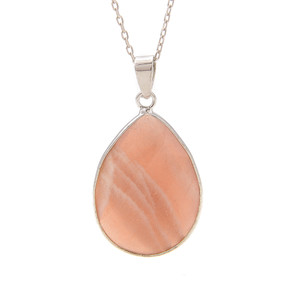
Moonstone, Faceted, Natural, Drop, One Pendant, 36x20mm
Moonstone, Faceted, Natural, Drop, One Pendant with a Metal Alloy Bail, 36x20mm
Moonstone is in the feldspar group that displays a pearly and opalescent schiller. Schiller is produced because of light interference because the light needs to weave its way through the layers with different optical properties. The best moonstone has a blue sheen, perfect clarity, and a colorless body color.
Moonstone has been used in jewelry for millennia, including ancient civilizations. The Romans admired moonstone, as they believed it was derived from solidified rays of the Moon. Deposits of moonstone occur in Armenia, Australia, Austria, Brazil, Mexico, Madagascar, Myanmar, Norway, Poland, India, Sri Lanka and the United States.
Moonstone is the state gemstone of Florida.
Difference between Moonstone and “Rainbow Moonstone”: Technically “Rainbow Moonstone” is White Labradorite. Labradorite is a calcium sodium feldspar and Moonstone is a potassium sodium feldspar and has a lower refractive index than Labradorite. Blue and white are the only colors for a Moonstone's sheen. White Labradorite, also known as Rainbow Moonstone exhibits rainbows and flashy colors such as yellow, orange, or purple. Rainbow Moonstone has been coined by the lapidary and mineral communities to describe this stone even though it is not a Moonstone, so we will also call it Rainbow Moonstone.
Hardness 6-6.5
This is a natural stone that has had no treatment other than cutting, drilling, and polishing done in China.
Metal Alloy is a metal made by combining two or more metallic elements, base metals, to give greater strength or resistance to corrosion. In mining and economics, base metals refer to industrial non-ferrous metals excluding precious metals, like silver, gold, and platinum. Base Metals include copper, aluminum, nickel, tin, zinc antimony, bismuth, lead and many more. Metal Alloy, also known as Pewter and is usually a tin based alloy 85-95% of the time but could also be zinc based.
In December of 1994, The US Safe Drinking Water Act defined Lead-free as having less than 0.25% lead content. Most newly made solid pewter on the market today is considered lead free by these standards. But it is still recommended to not give children Metal Alloy jewelry if there is any chance, they will put it in their mouths!







